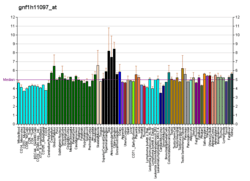OR51G2
Olfactory receptor 51G2 is a protein that in humans is encoded by the OR51G2 gene.[5]
Olfactory receptors interact with odorant molecules in the nose, to initiate a neuronal response that triggers the perception of a smell. The olfactory receptor proteins are members of a large family of G-protein-coupled receptors (GPCR) arising from single coding-exon genes. Olfactory receptors share a 7-transmembrane domain structure with many neurotransmitter and hormone receptors and are responsible for the recognition and G protein-mediated transduction of odorant signals. The olfactory receptor gene family is the largest in the genome. The nomenclature assigned to the olfactory receptor genes and proteins for this organism is independent of other organisms.[5]
See also
References
Further reading
- Gilad Y, Bustamante CD, Lancet D, Pääbo S (2003). "Natural Selection on the Olfactory Receptor Gene Family in Humans and Chimpanzees". Am. J. Hum. Genet. 73 (3): 489–501. doi:10.1086/378132. PMC 1180675. PMID 12908129.
- Malnic B, Godfrey PA, Buck LB (2004). "The human olfactory receptor gene family". Proc. Natl. Acad. Sci. U.S.A. 101 (8): 2584–9. doi:10.1073/pnas.0307882100. PMC 356993. PMID 14983052.
External links
- OR51G2+protein,+human at the US National Library of Medicine Medical Subject Headings (MeSH)
This article incorporates text from the United States National Library of Medicine, which is in the public domain.




